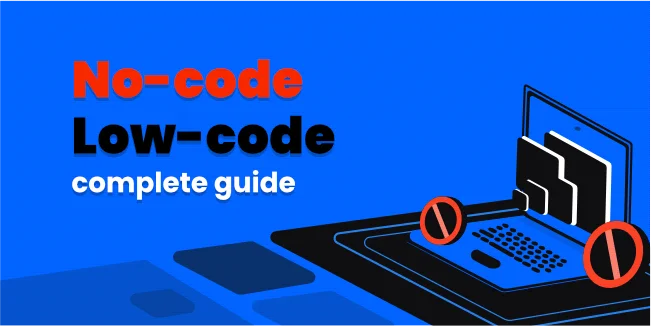Mobile Development
Technologies
mobileapp
no-code
low-code
No-Code/Low-Code Mobile App Development - Complete Guide

Today, fast multi-platform mobile app development solutions have become necessary for developing enterprise-grade applications. Businesses need rapid application development for digital transformation. These software approaches have replaced traditional development to create apps for business process management and promote the idea of "Citizen Developers."
These development tools offer visual interfaces to optimize programming, which makes mobile application development quicker and easier for business owners. By automating business operations through visual development, these tools can help streamline your workflows.
Before you create your software, you probably have a financial interest. It is a crucial topic when starting a project. Orientation in market prices can properly adjust to what the future may bring. Therefore, we are happy to say that we have prepared an article, "Software development costs - everything you need to know + Free Estimation" on this subject, in which you will learn all about what it can cost and why.
No-code development thrives on forming a citizen developer community in which anybody can develop apps even if they don't have any technical expertise. It implies that you must write a line of code when constructing an app. According to a worldwide poll, almost 70% of firms are moving their business procedures to low-code solutions.
Professional developers formerly spent significant time writing code for enterprise-grade applications before no-code app development platforms were widely used to develop apps. It was the era when these apps needed a lot of programming and time to build. At that moment, app development without any coding expertise was not feasible.
These no-code platforms have rapidly replaced the traditional development process in recent years, where professional developers now depend on them. They allow businesses to get tasks done quickly and easily, so that critical tasks can take priority.
The idea of developing an application may appear to be a difficult job that requires skilled developers and coding abilities. However, this process has become much more straightforward and rapid with several app development platforms. You can create mobile apps without hiring professional developers or possessing extensive programming knowledge using these low-code platforms! These technologies provide visual means to streamline and speed up business operations.
What is No-Code/Low-Code Mobile App Development?
While low-code technologies have grown in popularity, they are not the ideal solution for every company. You might be asking whether you should now develop these mobile app development platforms.
What is No-Code?

No-code is a rapid application development (RAD) approach. "No-code" refers to a software app development approach that does not require any code and is often equated with the modular plug-and-play low-code development style. While low-code has some handholding from developers in the form of scripting or manual coding, no-code has a total hands-off strategy that relies entirely on visual tools.
There are many things that no-code can be used for, such as self-service apps, dashboards, and mobile or progressive web apps. It is ideal for quick building and creating straightforward automation. Additionally, no-code works great for calendar planning tools and BI reporting apps with configurable columns and filters. In short, if you need something simple built quickly without any code, consider using no-code development tools!
What is Low-Code?

Low-Code is also a RAD approach. With low-code, you can create code automatically through user interfaces like drag-and-drop and pull-down menus. This automation lets users focus on the parts of programming that make their product different from others rather than the commonalities. Low=code is a happy medium between manual coding and no-code because it still allows some control for those who want to add their code over the auto-generated code.
Examples of mobile applications that lend themselves to low-code development include business process management platforms, website, and mobile app development, cross-department tools like appraisal management software, integration with external plugins, and cloud-based next-gen technologies, such as machine-learning libraries, robotic process automation, and legacy app modernization.
Similarities
No-code and low-code development platforms simplify coding using visual interfaces and templates. These app development tools are available as cloud-based solutions that use a workflow design to define how data moves between different steps. Many of their benefits come from this similar approach:
- Democratization of Technology - Low-code and no-code solutions are designed to assist many individuals. It lowers the need for difficult-to-hire, costly specialists and technologists.
- Productivity Enablers - Low-code/no-code allows developers to work more quickly, clearing IT backlogs and reducing project timelines from months to days.
- Less Risk at Quick Customer Feedback - Low-code/no-code allows businesses to get customer feedback by providing simple prototypes before committing a lot of time and resources to a project. It moves the go/no-go decision closer to the start of the project timeline, reducing risk and cost.
- More Build Than Buy - COTS products can be expensive and have a one-size-fits-all approach. Low-code and no-code incentivize in-house customization, shifting the needle towards "build" in the buy vs. build dilemma.
- Consistency at Architecture - Crosscutting modules like logging and audit benefit from a centralized low-code/no-code platform's design and code consistency. This uniformity is useful when troubleshooting apps since developers can focus on the problem rather than learning architecture.
- Cost-Effectiveness - Low-code/no-code is more cost-effective than from-scratch manual development for various reasons, including smaller teams, fewer resources, fewer infrastructure expenses, and lower maintenance costs. It also offers a higher ROI with faster agile releases.
- Business and IT Collaboration - In the past, development and business teams have tended to operate in a push-pull manner. However, as more business users embrace low-code/no-code methodologies, there is greater balance and understanding between the two seemingly distinct realms of endeavor.
Differences
Although there are many similarities between the two approaches, especially with how no-code and low-code development platform vendors market their products, there are still some key differences to be aware of:
Target Users
- No-code - Is designed for business users with a lot of domain knowledge who may be tech-savvy but cannot write code manually. It's also useful for hybrid teams of business users, software developers, small company owners, and non-IT personnel, such as HR, finance, and legal.
- Low-code - The goal is to prevent professional developers from wasting time on rewriting simple code, so they can focus on developing innovative features. This automation tool uses a syntax-agnostic approach, which makes it easier for developers to learn new coding languages and adopt new talent pools.
Speed
- No-code - It takes less time to construct than low-code since it's highly configurable and all plug-and-play. Because there is a reduced danger of unforeseen problems due to manual coding, testing time is also shorter. It's all about ensuring that the settings and data flow are correct in this case.
- Low-code - requires more training and time to onboard, develop and deploy as it offers more opportunities for customization. But it's still considerably faster than traditional development.
Use Cases
- No-code - This software is ideal for front-end applications that must be designed quickly through drag-and-drop interfaces. Applications such as data report generators, analytics tools, and data import/export utilities are good candidates.
- Low-code - With an extensive list of components, low-code can be used for mobile apps with complex business procedures and scaled up to meet the needs of a large enterprise. Additionally, because it can connect to other apps, external APIs, and multiple data sources, low-code is a better option than no-code for building systems that need IT oversight and security measures.
Shadow IT Risk
No-code - The drawback to no-code platforms is that they require little or no input from IT teams, thereby increasing the risk of shadow IT. It could then result in separate systems that are not well managed, which might cause security issues and technical debt. Low-code - The fact that low-code remains under the jurisdiction of IT teams can help ensure better governance and control.
Open vs. Closed Systems
- No-code - is a more closed system that can only be extended using templated feature sets. The upside to this is restricted use cases and access to boilerplate plugins and integrations. Still, the downside is you have less flexibility. It's easier to ensure backward compatibility as no code could break future versions of the NCDP.
- Low-code - is an adaptable system where users can write code to expand its functionality. For example, users can make custom plugins and data source connectors that fit their use cases and reuse them later. It's important to remember, though, that when new upgrades or patch versions of the LCAP come out, they need to be tested with the code added by the user.
Knowing the similarities and differences, you can better decide what is needed for your project. But low-code and no-code aren't the only elements you need to create the software you want. It is worth getting the right package of tools, i.e., a tech stack. If you don't know what this is, check out our "What is Tech Stack?" article, from which you will learn what a tech stack is, what it is used for, and why it is worth choosing the right one.
Is Low-Code/No-Code the Future of Software Development?

In the future, low-code/no-code platforms will dominate native app development because they offer various drag-and-drop options. Application developers increasingly rely on these automated tools to provide affordable business solutions.
Developers are not the only ones who can benefit from quick development; even beginners can quickly get started with programming. Quick development is affordable and easy to use, making it ideal for starting. Low-code development is the future of software development.
In the past, creating business apps required hiring an entire team of developers with in-depth coding knowledge. Automating workflows and keeping data centralized was a complicated process. However, no-code development solutions are now available that enable application developers to create mobile apps without extensive time or expertise requirements.
Centralizing data used to be a complex process that automated the workflow of businesses. But now, with no-code development solutions, application developers can create mobile applications quickly without extensive experience or expertise in business solution development.
The world is rapidly adopting the era of low-code, which signals a new beginning for application development. Soon, traditional development will be a thing of the past. Thanks to available tools, mobile apps can now be developed much faster and easier. Technology and application design can make your business app more interactive and give you a new low-code/no-code experience.
Adopting No-Code/Low-Code Development
In only six years, the vast majority of application development will be completed using a low-code platform, as stated in a Gartner survey. Additionally, the thought of empowering "Citizen Developers" has caused this technology to become more sought-after. The following are a few reasons why interactive apps are often created with low-code/no-code application development:
Cutting Costs

Traditional app development, not to mention mobile app development, has generally been more expensive. Traditional app construction used several phases and required substantial investment to finish. Furthermore, each iteration of the creation process included numerous developers.
With the arrival of low-code programming tools, changes can be made to apps quickly and without spending as much money on coding.
On the other hand, low-code application development requires no technical expertise and shortens the software development time frame. It also decreases the requirement to hire pricey experts and takes advantage of low-maintenance expenses for the program.
Cloud is The Answer
Before the invention of these tools, only big businesses could afford to develop applications by buying hardware. However, no-code/low-code platforms have allowed smaller companies to create cloud apps that suit their professional needs.
Small companies were handicapped before low-code platforms became popular, as they could not acquire hardware because of a lack of cash. On the other hand, software development in the cloud has made things simple for all sorts of enterprises.
To develop apps without worrying about infrastructure or costs, you need a decent internet connection and low-code platforms for application construction. The growing availability of these development tools has made developing with the low-code platform even easier.
Cloud technology is data-driven technology that provides a central server to store business data without requiring hardware or additional costs for maintenance. This technology helps businesses to develop enterprise-grade applications. These applications help businesses in workflow automation to meet specific business needs. You need not write a code line for app building when using these tools.
To Meet the Rising Demand for Company Apps
The demand for no-code application development is growing 5 times faster than conventional app building. These low-code application platforms have replaced programming languages and hired expert developers to create business applications for automated processes. To attract new consumers, you may automate operations with these low-code application development tools.
Finally, a low-code mobile app development platform removes the burden of work for professional developers. It allows them to focus on more critical tasks. Furthermore, these development platforms enable enterprises to convert to the digital era by providing rapid solution delivery.
Low-code platforms assist product developers in improving delivery by allowing them to create drag-and-drop components, dynamic user interfaces, and reusable elements.
IT Dependency is Reduced
Before the hype of low-code software in application development, standard app development necessitated a lot of coding throughout each phase to create an app that satisfies the company's demands in the best way possible. Entrepreneurs and small business owners constantly seek inexpensive company solutions to expand their businesses.
A few years ago, businesses with limited funds could not utilize scalability for their products and services. However, that has changed drastically today in small business owners' favor. The rise of low-code and cloud programming tools allows for rapid application development, which reduces the need for IT professionals' programmer involvement.
You might wonder what the future holds for computer programmers with coding and programming skills. The reality is that this development software won't limit IT software professionals' chances.
Although low-code development is more limited in scope than traditional programming, it can help software developers speed up procedures and finish projects faster. That isn't all; anybody may use low code. Even if you lack technical skills, you may start your career as an app developer.
With a few clicks, these applications can aid you in becoming a competent app developer. That is the elegance of low-code solutions. Furthermore, no-code platforms also supply the backend for apps and enable you to access and modify the source code if required.
Agility
Low-code development provides businesses with additional flexibility and agility. These technologies may assist organizations in replacing antiquated systems and developing more up-to-date ones to meet ever-changing customer demands and business environments.
Business apps may be developed without coding/programming knowledge using low-code platforms, which allow nontechnical users to produce company applications easily and quickly. Business apps are just a few clicks away from low-code application development without needing a developer team with these technology solutions.
No-code development tools make it easy to update and redesign applications with simple drag-and-drop features. These tools are robust and supportive for any application, developer, or entrepreneur.
You may create apps that run on cross-functional platforms and devices using these development approaches. Above all, these platforms provide many cloud technical features that allow users to access this data in seconds.
Will No-Code Replace Developers?

The question of whether no-code/low-code platforms will eventually replace professional developers is still up for debate. The answer to this question depends on the application you're attempting to build apps. You'll want experienced coders working on it if it's a more complex project. Using a no-code platform could suffice if it's a smaller project or one that doesn't require as much finesse.
The use of databases to develop apps with various features for individuals from all walks of life is becoming increasingly popular. Without a doubt, no-code tools have come a long way, and businesses are utilizing them to expand their reach to potential consumers.
We recommend using no-code development platforms to build an app with simple features. Furthermore, no-code platforms can speed up the development process considerably. A novice user can create anything they desire as easily as a no-code tool.
However, we recommend hiring professional developers to develop a complicated project like creating a chatbot for your website or CRM, ERP, or HRM systems. As a result of this connection between utilizing these technologies and employing a development team for development, there is also an implicit link between using these tools and recruiting a development staff.
Low-code solutions are helpful for custom web developers because they can deliver great products faster. Business owners who use no-code development platforms can develop applications using templates without needing to code. However, there are some limits to no-code solutions - manual coding might still be necessary in some cases.
No-code applications with all kinds of features have not been created to replace skilled developers; rather, they are meant to help anybody from any background develop various apps in a few seconds. In addition, these no-code online solutions save web designers the trouble of writing code for their projects.
By using no-code platforms, an offshore outsourcing company can get a sense of what these software programs have to offer. These platforms not only help experienced personnel create apps but also aid even novice users in developing both online and mobile applications.
Application builders that don't require coding are fantastic for business owners because they can create applications with chatbot features without having any prior coding knowledge. Consequently, business owners who use these application builders will likely finish projects faster and have more time to dedicate to other tasks.
Conclusion
We hope you are familiar with these platforms' position in automating business procedures. You have the option to shift your company to no-code/low-code technology.
As an entrepreneur, you must know the distinctions between these development technologies. If you do not have a technical background, low-code solutions are an option; but if you lack this understanding, no-code solutions are also available.
Low-code/no-code software development platforms provide great potential and opportunities for organizations of all sizes. On the other hand, creating an app is easy with the appropriate no-code solutions.